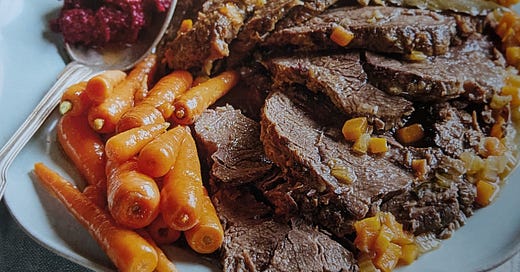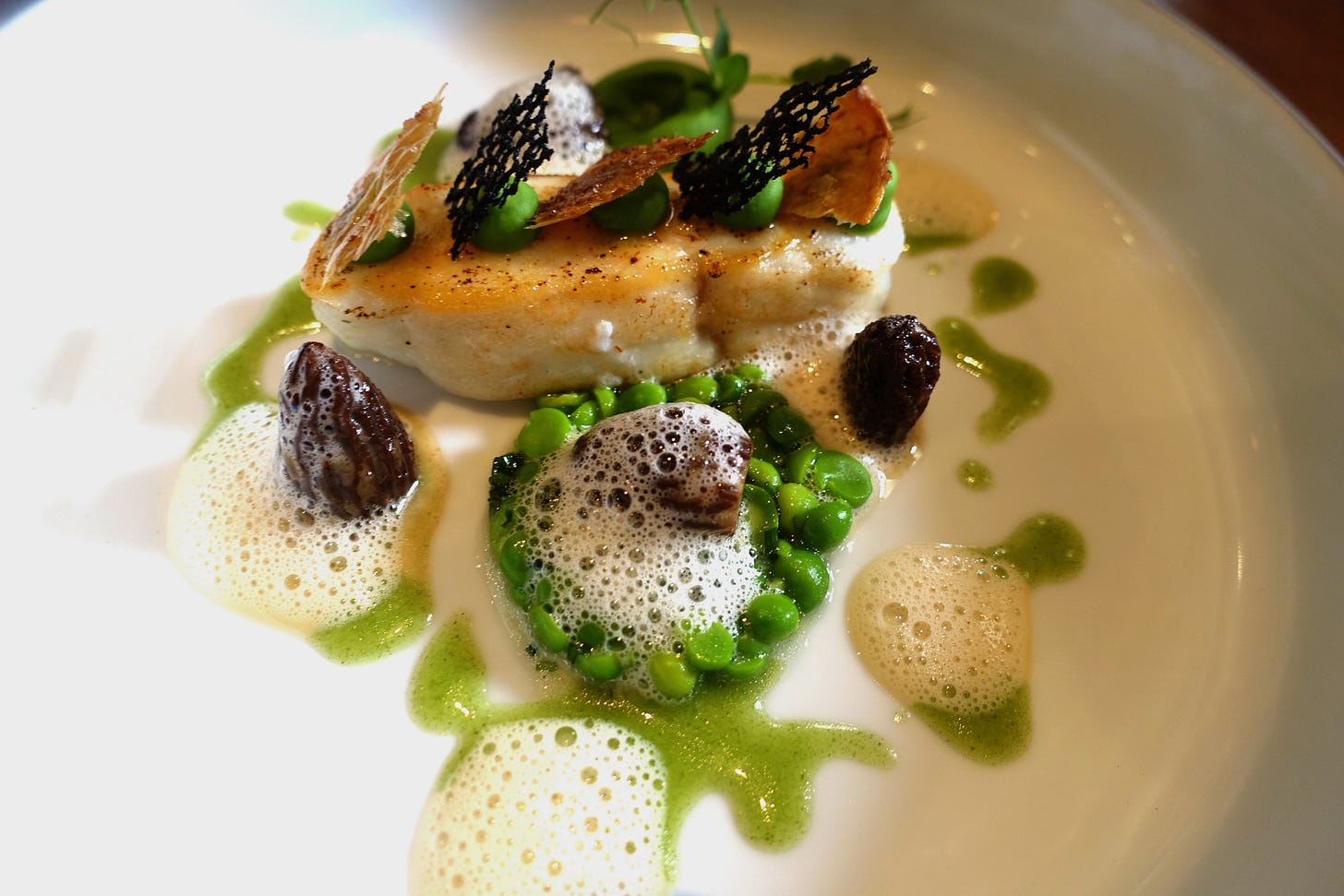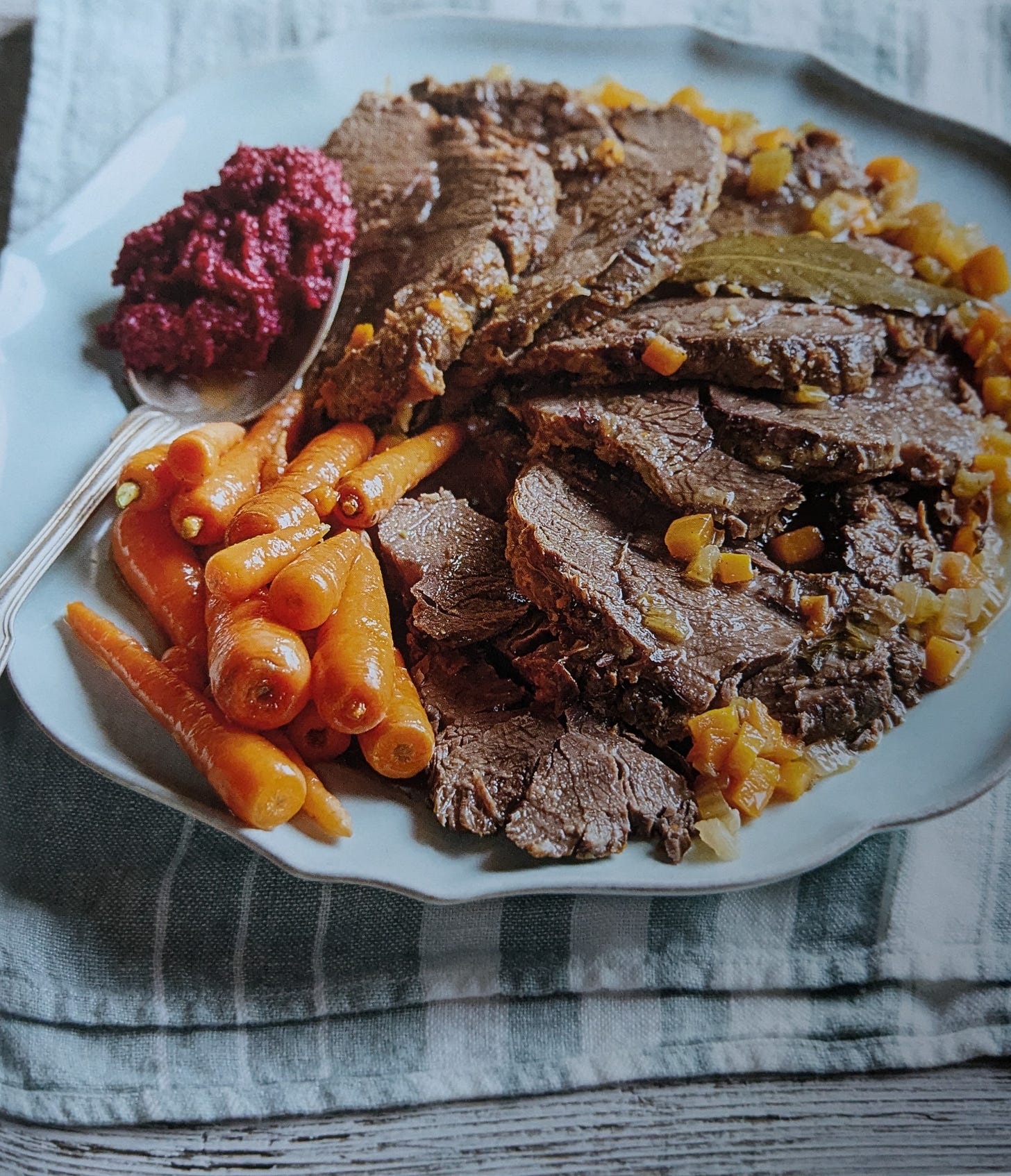Jus or gravy? Getting back to basics
Recipe for Boeuf à la mode with beetroot and horseradish puree
At the risk of alienating Francophiles, I am SO over French food. ‘Fine dining’, that is, delicious though it can be. I far prefer the honest fare of bistros - the steak-frites, moules marinière, coquilles St Jacques, soupe à l’oignon and all the other unpretentious cooking that greeted post-war visitors from the 1950s onwards. What I can no longer abide are the foams, the dots, the squiggles of jus, the artful arrangement of very little food on a self-conscious piece of crockery. It is all so out-of-date.
There’s no denying French haute cuisine involves, as does Chinese cooking, some remarkable techniques and innovations. The French are responsible for most of the foundations for western dishes that we know and love - béchamel sauce, mayonnaise, bouillons, and more. The Ancient Egyptians may have invented pastry but it took French introductions of sugar and quantities of butter to give us the flaky confections we can’t resist today. (And if you want even more elevated versions of patisserie, seek out Japanese pastry shops. They leave the French classics in the dust.)
If you offer me a choice between the dishes typical of a French Tasting Menu and something from Italy or anywhere in South East Asia, or pretty much anything currently on a menu in London, I’d jump at all the latter.
As much as fashion, food is subjected to trends. And the trend for a while has been going back to simple cooking, to the showcasing of ingredients that haven’t been smothered in sauces and strangled by complex technique. If Ferran Adrià were to launch today, would his scientific confections impress other chefs and diners as anything more than foodie sleight-of-hand curiosities?
It may have been global austerity, or it may have been the Covid lockdowns that pushed us into nursing a nostalgia for reassuring ‘retro’ dishes. Prawn cocktail enjoyed a revival. Meatloaf stormed menus. Roulades returned. Then amplified fears over climate change and global unrest ushered in an extra layer of emotional need and a hankering for comfort foods: tray bakes, pasta bakes, casseroles and thick soups came back, dishes to make us feel cosy and cossetted.
Now hijacked by little trust in anything, a move towards ‘rustic’ food has taken over. We want real. We want authentic. We want handcrafted cheeses, beers, batch-bottled spirits, a return to old-established traditions. In this unquiet world in which fundamental values have been abandoned, they make us feel safe. One-pot meals are all over the internet, easy to make, quick to compose, filling and hearty. There’s no time and little interest in dairy-rich dishes created from carefully contrived methods and techniques designed to produce a plate of food as pretty as a (phone-camera-ready) picture. These days, diners lean towards simple, healthy food whose ingredients can be identified intact.
Even on Tasting Menus, the trend is more towards a clean and minimalist Japanese or Asian cooking ethos than a classic French one. Eating what were beautiful and indisputably delicious dishes at a 4-star restaurant in France this summer, I was taken aback by how little pleasure they were giving me. And how out-of-touch the whole meal was.
Besides, rustic food is cheaper. One-pot meals don’t necessarily require the switching on of an oven. Stews are created from inexpensive cuts. Triumphant dishes can be thrown together from store cupboard staples. Deliberate left-overs transform into another meal. This is how our grandparents cooked.
You know it’s a Thing - just look at your supermarket shelves. Manufacturers have replaced ‘Natural’, their previously favourite word on packaging, with ‘Rustic’ and ‘Rural’, ‘Artisan’ and ‘Country-style’.
When/if we come out of recession, we doubtless will celebrate with a change in our eating habits that reflects new-found financial flexibility. But until then, honest rustic food bolsters our health and the economic well-being of those small producers providing the ingredients for this more relaxed way of dining.
I’m up for that. Let’s support the trend as long as possible. Because when the pendulum swings back, as inevitably it will, we’ll be stuck in the kitchen for hours once more, reducing and poaching and flambéing and sweating over a hot stove.
This French recipe is classic bistro and home-comfort fare, one of the mainstays of French cooking, a pot roast that’s not quite the same as an American one. One set of ingredients creates two different meals. The second is Boeuf à la mode en gelée - Cold jellied beef, in which the stock of the original pot roast has been enriched with a gelatinous calf’s foot then clarified through stiffly beaten eggs whites (yes - there’s a classic French culinary technique right there!), poured over the sliced beef and left to chill into a jelly.
Boeuf à la mode not only improves from being made 24 hours ahead (without the whole carrots) then reheated, but this lets you easily prize off any remaining chilled fat.
Serves 6-8
2 tablespoons oil
2kg/4 lb 4 oz braising beef - rump or topside, tied in string
1 tablespoon butter
150g/5 oz each of carrots, onions, and celery, very finely diced
1 bay leaf
sprig of parsley
sprig of thyme
240ml/1 cup beef stock
Bunch of carrots, scrubbed
Knob of butter
salt and pepper, to taste
2 tablespoons Madeira or port
handful chopped parsley leaves
Preheat the oven to 150C/300F.
Heat the oil in a large casserole, add the beef and sear until brown. Spoon out the fat and discard. In a small frying pan, melt the butter then add the finely diced vegetables and stew over low heat till soft, 8-10 minutes stirring often. Add to the casserole with the herbs and stock, scraping up the meat caramel at the bottom of the dish. Bring to a simmer on top of the stove. Skim the fat off with a spoon, cover with a large piece of crumpled and wetted parchment paper, then the lid, and transfer to the oven. Braise for 1½ hours.
If you’re serving the same day, skim off any remaining fat by laying paper towels over the surface, keeping a hold of one corner. In a covered saucepan, poach the carrots with a knob of butter in a wine-glass of water over medium high heat for 5 minutes until just tender. Remove the lid halfway through to cook off the liquid. Season, and keep warm.
Hoist the beef out of the casserole. Slice thickly and add to a warm dish with the carrots. Cover and keep warm. Strain the braising juices through a sieve into a heated jug. Stir in the Madeira and season to taste. Sprinkle the beef with chopped parsley and serve with the bowl of sauce.
I like to pass round this beetroot and horseradish puree.
900g/2 lbs beetroot, scrubbed, leaves and roots removed
30g/2 tablespoons butter
2 medium onions, peeled and sliced
1 large clove garlic, peeled and sliced
2 apples, peeled, cored and chopped
60ml/¼ cup wine vinegar
1 tablespoon sugar
1-2 tablespoons freshly grated or bottled horseradish to taste
Preheat the oven to 200C/400F.
Cover the beetroots with salted cold water in a pan and bring to the a boil, then simmer, covered but with the lid on at a tilt for to allow the steam to escape, till tender when pierced, 30-40 minutes depending on size.
Heat the butter in a large pan. Sweat the onion over low heat 8-10 minutes until soft, adding the garlic after 4-5 minutes. Add the apples, stir well, then stew until they too are soft. Add the beetroots, vinegar and sugar to the pan. Cook everything down until sticky, about 5-8 minutes stirring two or three times, then take off the heat. Cool a little, then blitz to a purée with a hand blender or in a food processor. Fold in the horseradish, and serve in a bowl.






I couldn’t agree more about the pleasures of simple food. I have been married to a French man for 40 years. We’ve been going back & forth from 🇺🇸 to 🇫🇷 since then. We’ve never once eaten French haute cuisine in France. We’ve been to a few such restaurants in the DC area & NYC & while back in the day, La Colline, Citronelle & Jean-Louis at the Watergate were fantastic experiences, I wouldn’t want that often.
My 🇫🇷 MIL taught about producing simple, delicious meals. Her dinners began with/a homemade, puréed vegetable soup of many sorts, perhaps a whole chicken cooked wi/onions, potatoes and carrots, a green salad w/homemade vinaigrette & finally, a cheese course & fruit. There was always a fresh baguette.
I’ve cooked that way ever since & we eat that way in 🇫🇷 w/family, friends & at the corner bistro.
Thank you for your delightful post.
You're putting ideas in my head! Definitely one for the slow cooker, and variations on the theme for a week! (I'm on my own, so a large recipe like this tends to be portioned out and some of it frozen!) I like the sound of your beetroot and horseradish purée. A dish of Savoy cabbage, braised in cream, or sautéed with sesame seeds as a side ... A propos, my favourite bistrot in France served me up a dish of boudin noir and potatoes braised in cream, with a leafy salad dressed with a drizzle of balsamic vinegar (the thick, sticky kind!). Food for the gods, and couldn't get much simpler. And I absolutely loathe those awful foams (cuckoo spit on a plate!), so delighted they're losing favour!